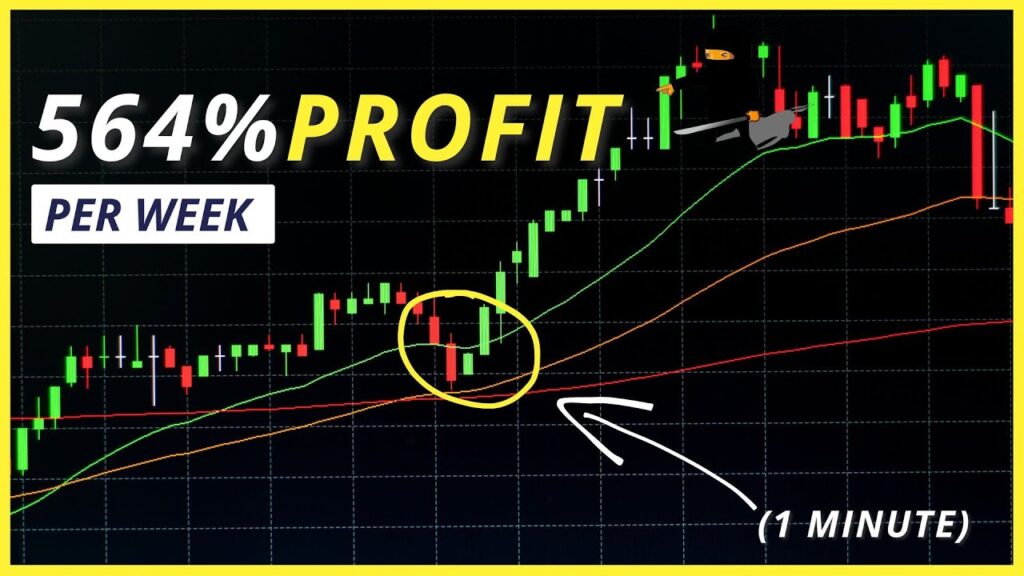Welcome to Ninja Crypto Trader!
Today we’ll be taking a look at another scalping or day trading strategy that you can use with cryptocurrency.
This strategy can be used for both scalping and day trading, and thus I’ll use both the five-minute and one-hour time frames to show how this strategy works, so let’s get right into it.
For this strategy, we are going to use two exponential moving average indicators. The first one will be a 10-period exponential moving average, and the second will be a 20-period exponential moving average, so let’s put those on the chart.
As I said, the first one will be a 10-period exponential moving average, so we set the length to 10, and we’ll make this blue and just bolden it a bit more.
And there we have the blue line as a 10-period exponential moving average.
The second one will be a 20-period exponential moving average, so we change the length to 20, and we will make this orange and bolden it a bit more.
So there we have our two exponential moving averages on the charts.
We will also add another indicator, but this is my own personal preference, and you will see where it comes in. So I will be adding an RSI indicator.
This will come in a bit later, so we can reduce the area where the RSI is a bit and focus on this main part of the chart where we have our two exponential moving averages.
This is a trend strategy and therefore uses two exponential moving averages to determine the trend.
When the 10-period exponential moving average is above the 20-period exponential moving average, we are in an uptrend and vice versa.
So how do we get signals for trading with these two exponential moving averages?
Let’s take a look at a long entry signal.
First of all, we need to confirm that the 10-period EMA is above the 20-period EMA.
As you can see here, the blue line is above the orange line.
Secondly, we need a pullback of the price to either the 20-period or 10-period EMA.
As you can see here, we are in an uptrend, and price actually pulls back onto the 10-period exponential moving average.
Third, we need to see a bullish confirmation appearing, for example, a bullish candle.
Here, as you can see, we have this bullish hammer that comes and finds support on the 10-period exponential moving average.
Once we have this confirmation, we can get into the trade here.
Now, for our stop loss, we will be placing it at a previous point of support.
So if we do take a long position here, we can place our entry point there and have our stop loss at this area of support around here, as you can see.
There are two rules that you can use for exiting this trade in profit.
First, you can wait till we have a cross of the exponential moving averages, which you can see here.
So you can set your take profit point at this level.
Why I was talking about the RSI is that we can also use the RSI to set or take profit in levels where we are in an overbought scenario.
As you can see at this point here on the RSI, we are in an overbought area at this point.
So you can also bring your take profit point there, and as you can see, we have a 2.44 risk-reward ratio, which is really good.
This is the long entry signal that we will be using with this strategy.
As you can see, it gives you very good returns in a short period of time on the five-minute time frame.
Now let us look for what we will want to see when we get into a short trade.
For a short trade, first we need to confirm a downtrend, and we can see here we go into a downtrend as the 10-period EMA is below the 20-period EMA.
Secondly, we need a pullback into these two exponential moving averages, which we have here.
Third, we need confirmation of a bearish signal.
So we have this candle here, which is an inverted hammer, which is a bearish signal as price tried to go up, but there was not enough strength and thus was brought back down where it closed.
We can enter our trade around this area.
Here specifically, I wanted to show this trade to show you another way we can be using our stop loss levels.
If we do enter this trade after this candle has closed, we can show our short position as coming in anywhere around this candle.
Here we can use the 20-period exponential moving average as our stop loss level.
Also, as we can see, there is no point before we get this cross back into an uptrend where the RSI goes into an oversold zone to be able to give us an exit point for our take profit.
Here we can just use this area where we get a cross of the two EMAs back into an uptrend because we do not want to be holding a short position when the price is going into an uptrend.
As you can see, our risk-reward ratio is 2.08, which is still really good.
I will show another example on the one-hour chart just so you can see how this strategy works in a different time frame.
Here we are on the one-hour time frame, and we’ll be looking at this short entry point here.
Remember the rules: first, we need to confirm that we are in a downtrend, and as you can see, the 10-period EMA is below the 20-period EMA, confirming the downtrend.
Next, we need to see a pullback into any of these two EMAs, which we do see at this point.
Third, we need a bearish confirmation, which we get after these two candles.
We will open our short trade at this point anywhere on this candle, and if we do that, we can see that we have our entry point at that candle.
We can set our stop loss at the 20-period exponential moving average, and at this point, we get a cross into the oversold zone on the RSI.
We can move our take profit point anywhere around this area, which gives us a very good high risk-reward ratio.
As you can see, this strategy is very simple to follow and, if done well with discipline, can give you a lot of profits.
One thing I want to mention about the RSI: one way of setting your take profit point is by using points where we have a cross in the opposite direction of your trade.
If you are in a long trade, when you get a cross where the 10-period EMA goes below the 20-period EMA, showing that we’re going into a downtrend, you can close your trade.
You can also use the RSI: if you’re in a long trade and you get into an overbought scenario where the RSI is above 80, you can close your trade.
If you’re in a short trade and you get into an oversold scenario where the RSI is below 20, you can close your trade.
You could also use other indicators that suit your trading style, for example, Bollinger Bands, Stochastic, or Fibonacci levels, depending on what you would like.
That brings me to the end of this strategy.
I hope you’re able to pick up a thing or two from this.
If you like the platform that I’m using in this video, it is known as Bybit.
If you want to trade cryptocurrency on Bybit, you can do so by clicking the link above.
If you don’t have an account with Bybit yet, you’ll get a free bonus on your first deposit, so go ahead and click that link.
If you enjoyed this video, please hit that like button.
Don’t forget to subscribe and hit that notification bell so you never miss out on more cool trading strategies.
By this, I am signing out.




